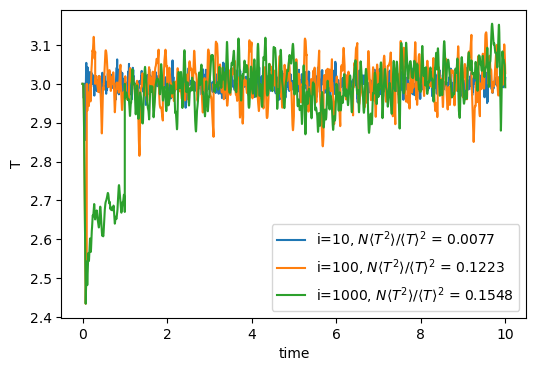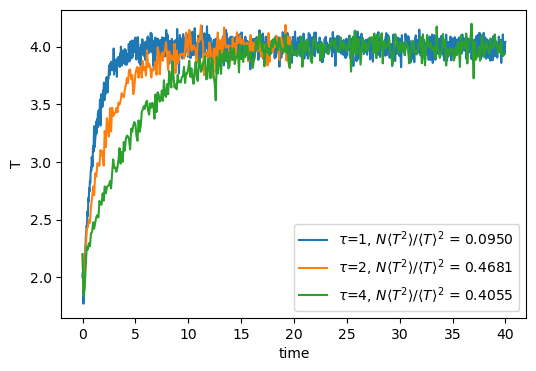Next: Stochastic NVT Thermostats: Andersen, Up: Molecular Dynamics at Constant Previous: Temperature Fluctuations in the
“Isokinetics” refers to altering velocities on the fly to keep kinetic energy (and therefore temperature) constant. The relationship between kinetic energy and temperature results from the application of the equipartition theorem to velocity (or, equivalently, momentum) degrees of freedom:
| (202) |
The code mdlj_isok.c illustrates implementation of an isokinetic thermostat for constant-![]() simulation of a Lennard-Jones fluid. The implementation uses a two parameters,
simulation of a Lennard-Jones fluid. The implementation uses a two parameters, isoKT and isoKi, that specify the desired temperature and the number of time steps between applications of the rescaling. It is worth asking whether or not occasional velocity rescaling (rather than at every step) might allow us to preserve the correct statistics. Fig. 22 shows traces of temperature vs time for three MD simulations of the Lennard-Jones fluid with 512 particles at a density of 0.50. Each simulation used a different interval size i. The quantity
![]() is computed for each set and values are shown in the legend. For pure canonical statistics, we know this should be 2/3; clearly, isokinetics even at a very modest frequency utterly fails to preserve canonical statistics.
is computed for each set and values are shown in the legend. For pure canonical statistics, we know this should be 2/3; clearly, isokinetics even at a very modest frequency utterly fails to preserve canonical statistics.
 |
Berendsen realized that velocity scaling could be reformulated to model energy exchange
with a bath at constant ![]() [9]. His scale factor is defined as
[9]. His scale factor is defined as
The code mdlj_ber.c
implements the Berendsen thermostat. The two relevant parameters are berT, the setpoint temperature, and ber_tau, the rise time. Fig. 23 shows traces of temperature vs time for three MD simulations of the Lennard-Jones fluid with 512 particles at a density of 0.50, with temperature controlled using the Berendsen thermostat with various values of ![]() . Larger
. Larger ![]() clearly results in longer approach times to the setpoint temperature. Note also that the relative fluctuations of the temperature reported indicate that canonical statistics are not being held.
clearly results in longer approach times to the setpoint temperature. Note also that the relative fluctuations of the temperature reported indicate that canonical statistics are not being held.
 |
Though relatively simple, velocity scaling thermostats are not recommended for use in production MD runs because they do not strictly conform to the canonical ensemble.
cfa22@drexel.edu